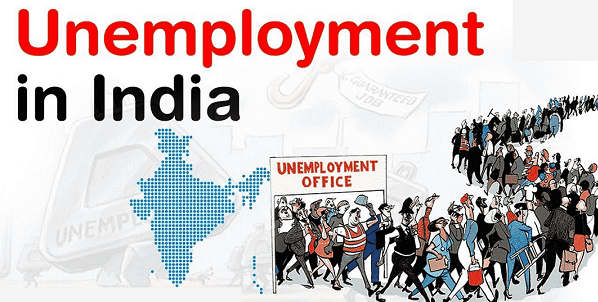Unemployment Essay"The real minimum wage is zero unemployment." - Thomas Sowell In terms of population, India ranks second in the world with a population of around 1.4 billion. It is likely to surpass China to become the most populous nation in the world. An increasing population and limited resource base are highly problematic situations. Its consequences are pretty direct and interconnected. Unemployment is one such peril which can further lead to poverty, malnutrition, reduced standard of living, etc. It is a situation wherein the total number of jobs is way too less in comparison to the population. People who are willing to work are not able to find any jobs, and it leads to sheer wastage of human resources. Advancement in technology has further reduced the dependence on human labour. 
John Maynard Keynes explains that unemployment in advanced economies is due to a lack of effective demand. This means that the demand for labour decreases, and the demand for industrial goods also drops. The problem of unemployment in India is caused by a shortage of capital equipment and other resources and a high rate of population growth instead of a lack of effective demand. Types of Unemployment:(i) Frictional Unemployment:Because it takes time and effort to match job seekers' skills and job requirements, unemployment and unfilled vacancies can exist simultaneously. Frictional unemployment is unemployment that occurs when there are unfilled jobs in the same occupations or the same locations. This is because people move and should be encouraged and supported to leave places, jobs and industries that are low in productivity to work in places with high productivity. (ii) Structural Unemployment:The unemployed who are not matched with job openings because of their lack of skills or living in areas that do not offer top opportunities will experience more stubborn friction. This mismatch creates structural unemployment. Three ways technological change could cause an increase in structural unemployment-
(iii) Seasonal Unemployment:Seasonal unemployment is easy to understand. Seasonal unemployment can occur in activities such as construction, agriculture and canning. The weather or calendar decides when production can continue or when it can be stopped. For example, when a farmer sows the seeds of a particular crop, then it takes time for them to grow when the right conditions are provided. Until the time the crops are ready to be harvested and sold, the farmer remains unemployed. They may or may not take up any alternate job during this time. Seasonally adjusted unemployment statistics measure the strength of demand in the labour market and the business cycle. It can also be called under-employment. (iv) Unemployment due to Demand Deficiency:This happens when there isn't enough work demand for all workers, regardless of how they are trained or deployed. This means there are more people in the economy who are unemployed, and the number surpasses that of job vacancies. The term "cyclical unemployment" was once used to describe demand deficiency. This indicates that there may not have been enough demand even at peak business cycles. (v) Voluntary and Involuntary Unemployment:It is possible to classify unemployment by dividing it into voluntary or involuntary unemployment. A worker is considered voluntarily unemployed if he is offered a job he can fill but refuses to accept it. If a worker cannot find a job despite being qualified and willing to work at the existing wage rate, he is considered involuntarily unemployed. Involuntary unemployment is due to demand deficiency, and voluntary unemployment is frictional. (vi) Disguised Unemployment:
The term disguised unemployment is used to refer to individuals who are engaged in a job which doesn't utilise their work potential fully. Even if such individuals stopped working, their exit wouldn't affect their productivity much. But their departure might reduce the amount of effort available to the community at critical junctures in the agricultural work cycle and thus erode annual agricultural productivity. Disguised unemployment is also treated as a part of structural unemployment. For example, on an agricultural farm, there is a requirement of 3 people, but 6 of them are working. Now, the remaining three would appear to be working, but their absence also would not affect the work because, ideally, only three people are required for the job. So those three extra people are disguisedly unemployed. Causes of Unemployment in India-These are the factors that contribute to India's unemployment crisis: 1. Dependence on Agriculture Sector
Due to the heavy population pressure and primitive agricultural methods, rural areas are experiencing unemployment and underemployment. India's population is 70% dependent on agriculture, which pays low wages per worker and per unit of land. Because labourers are poor, they cannot afford to cultivate better land. One of the reasons behind the financial crisis that farmers face is the small size of the land holdings by repeated division among children. Agriculture is a seasonal occupation, and there aren't many other employment options. 2. Insufficient Industrial DevelopmentIndia has a lot of labour, but there is a lack of technology, shortage of industrial raw materials, erratic power supply and transport bottlenecks, as well as industrial unrest, which are problems. The industrial sector was unable to work at its full potential and could not absorb sufficient labour to create enough employment opportunities. 3. Migration of LabourAfter earning money in urban industrial units, labourers often return to their villages. They return to the urban areas after they run out of their money. Employers are reluctant to hire migratory workers because they don't have the skills to do the job on a permanent basis. They are thus again unemployed. 4. Capital Intensive Technique is the FocusThe country's industrial developments have been largely based on capital-intensive production methods that have failed to create enough employment opportunities. In India, industrialists have constantly resorted to modernisation, market manipulations, rationalisation, automation mechanisation, and other labour-saving tools. Thus, the process of replacing human labour with machines has been continuous. The Government has focused a lot on the establishment of capital-intensive industries, such as irrigation projects and road building equipment. These industries are unable to absorb a sufficient labour force. 5. The Government's Policy Towards Private EnterprisesThe Government's policy toward them hinders private enterprise growth. Private enterprises are subject to strict government regulation and control. Due to the price spiral and inflationary pressures, private enterprises are discouraged by starting new ventures or expanding existing ones. 6. Too Much Population Growth
From 1951-61, India has seen a manifold rise in its population. Between 1951 and 1991, India's population grew at an average annual growth rate of 2.1-2%. The labour force has grown rapidly during the Plan periods due to this high growth rate. It has been difficult to create enough employment opportunities to absorb such a large and growing labour force. Therefore, unemployment and underemployment tend to rise. 7. Defective Educational SystemThe Britishers passed down this system. It is a general, literary education that lacks any practical content. It has not been possible to keep up with the economic demands of our education system. Higher unemployment has been caused by the adoption of an 'open door policy at secondary and university levels. Currently, there are 135 universities in the country. Each person who graduates from these universities contributes to educated or white-collar employment. There is no doubt that the trend has been inclined toward commerce, engineering and medicine for some time, but due to a lack of skilled manpower and low level of vacancies, unemployment can also be found to a certain extent. 8. Absence of a National Employment PolicyExcept for a few schemes and plans, no solid policy was introduced to tackle unemployment after independence. Instead, creating employment opportunities was seen as an after-effect of the development of the first three five-year plans. There has been no legal provision for employment-generating schemes. Manpower planning has not been seriously considered. The absence of a clear-cut policy for employment leads to both unemployment and underemployment rising tremendously with each plan. 9. Slow growth of the Indian economyThe growth of an economy is directly related to increased employment opportunities. The Indian economy has experienced a steady growth rate of 3.71% per year over the past four decades, despite more than 40 years of planning. This was from 1950-51 through 1989-90. Many of India's vast natural resources are still unutilised and underdeveloped. It has taken a long time to transform agriculture. The industrial sector's Development has been slow. As a consequence, the growth of the labour force has been slow. 10. Decline in Cottage and Small Industries
Many artisans and workers in these industries have lost their jobs as large-scale industrial production now produces the goods previously produced by small and cottage businesses. Although the Government of India has made many efforts to promote these industries, large numbers of rural workers are still unemployed. 11. Caste System and Personal BiasIndia is a country with a lot of diversity in terms of language, religions, castes, race etc. People of certain castes are often given employment, which can lead to many deserving candidates being jobless. This increases the number of unemployed educated people. Personal bias can also play a significant role in increasing unemployment. People who are of a particular caste are often highly recommended. 12. Capital FormationInvestment and employment are directly linked to capital formation. India's savings rate is very low, which has led to lower investment and, consequently, less capital formation. Even the available capital has not been properly used. Remedial Measures for Unemployment-The following policies are suggested to address the causes of underemployment and unemployment- 1. Mass Production of GoodsModifying the Indian production system can create employment. It is important to focus on producing goods that require more labour and less capital investment. These goods should actually be made that are more in demand by the masses to ensure they have a ready market. In large industries, labour-intensive techniques should also be used. 2. Giving Boost to Small EnterprisesSmall and medium-sized industries should be encouraged under the self-employment scheme. They should receive financial assistance, training in technical skills, and access to infrastructural facilities. This includes marketing products. According to a study done in Punjab, Rs. One lakh invested in fixed assets creates employment for 15 workers in small-scale sectors, compared to 3 in large-scale industries. It is, therefore, better to support small-scale industries that are highly employment-intensive. 3. Decentralisation PolicyPeople have begun migrating to larger cities as a way of finding work. It has led to the problem of urbanisation. Therefore, it is important to support and encourage the establishment of small-scale industries around small towns so that people can find employment in small towns as well. Sugar factories should be established in areas that are rich in sugarcane. The establishment of agro-based, cattle-based industries based on the availability of resources near rural areas will help to develop the area and offer more employment opportunities. 4. Rebuilding the Educational SystemLiberal education should be offered up to the middle level. Secondary education should also be vocationalized. Only those with high academic achievement should be allowed to attend college and university. The requirements for engineering, commerce, and medical should be determined based on an accurate economic manpower plan that takes into account the future and present demand for skilled workers 5. Strict Enforcement of Land ReformsRural areas have a high number of unemployed and underemployed people (including those who are engaged in disguised unemployment). These are mostly landless farmers and marginal farmers. To ensure that the land is given to the farmer, it is necessary to enforce land reforms. It is important to encourage marginal and small farmers to start other industries, such as poultry building, dairy farming, and beekeeping so that their income can be supplemented while they are still partially employed. Rural works programs such as road building, canal digging and soil conservation should be started in areas that rely on rains to support agricultural operations. Employed persons should be remunerated both in cash and kind. 6. Adoption of Labour-Intensive MethodsOther than heavy industries, there are many other areas such as defence, chemical and power generation. In new areas of production, labour-intensive techniques must be used. This could be somewhat what Schumacher called 'intermediate tech', or adapting imported technology to the country's factor endowments to absorb more labour. Research and Development are required on a large scale in order to create such labour-intensive techniques. 7. Maximum Utilisation of Excess CapacityThe Government should work to eliminate bottlenecks such as transport, power supply, and raw materials so that those industries working below their capacity can produce to their full potential. This would increase output and create more jobs. 8. Population StabilisationWithout population planning and control, the problem of India's unemployment will not be solved. Gainful employment can be found at any rate, given the incredible growth in India's labour force. Therefore, it is imperative to take the necessary steps to promote family planning. 9. Policy on Labour & EmploymentNational Wage Policy should be designed in a way that eliminates irrational or unequal wage and salary disparities and streamlines institutional mechanisms for wage fixation. The goal of the employment policy should be to increase employment opportunities. Existing special employment programs should be designed to guarantee work in the future, especially for those who are poor. Avoid 'Crash Employment' programs as they cause more resource wastage and don't provide permanent employment. 10. Self-EmploymentThe agricultural sector is where the majority of self-employment takes place. The Government can encourage it by offering farmers land, credit, loans, and seeds at concessional rates. Self-employment programs can also be created in areas like trade, cottage, small-scale industry, transport, and restaurant. Aspire Scheme, Micro-Credit Scheme for Self-Help Groups, and Pradhan Mantri Mudra Scheme are some government initiatives to encourage self-employment. 11. Capital Formation RateAn increase in job opportunities can be a direct result of the increase in capital formation. High capital formation and a low capital-output ratio are important. A capital-output ratio of 4:1 means that production is worth only one rupee; capital worth four rupees should therefore be invested. If there is a high capital-output ratio, an increase in capital formation won't generate employment. ConclusionThe menace of unemployment has various layers to it. There are many problems which are both the cause and consequence of Unemployment, thus, forming a vicious cycle. It is important that we tackle all these problems simultaneously so that the problem of Unemployment can be solved. Mike Rowe has rightly said, "There's a belief... in the country that we can cure unemployment by creating opportunity. The skills gap proves that opportunity alone is not enough to get people employed."
Next TopicEssay on Cricket
|
 For Videos Join Our Youtube Channel: Join Now
For Videos Join Our Youtube Channel: Join Now
Feedback
- Send your Feedback to [email protected]
Help Others, Please Share









